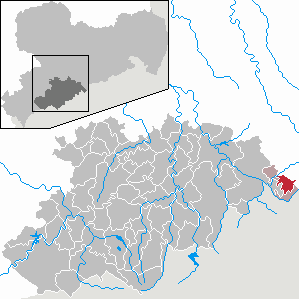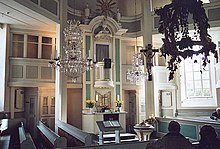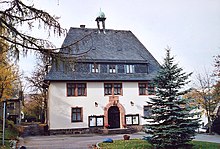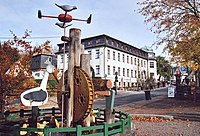Seiffen / Erzgeb.
| coat of arms | Germany map | |
|---|---|---|
 Help on coat of arms |
Coordinates: 50 ° 39 ' N , 13 ° 27' E |
|
| Basic data | ||
| State : | Saxony | |
| County : | Erzgebirgskreis | |
| Management Community : | Seiffen / Erzgeb. | |
| Height : | 650 m above sea level NHN | |
| Area : | 12.43 km 2 | |
| Residents: | 2098 (Dec. 31, 2019) | |
| Population density : | 169 inhabitants per km 2 | |
| Postal code : | 09548 | |
| Area code : | 037362 | |
| License plate : | ERZ, ANA, ASZ, AU, MAB, MEK, STL, SZB, ZP | |
| Community key : | 14 5 21 570 | |
| Community structure: | 2 districts | |
| Association administration address: | Am Rathaus 4 09548 Kurort Seiffen |
|
| Website : | ||
| Mayor : | Martin Wittig ( CDU ) | |
| Location of the municipality of Seiffen / Erzgeb. in the Erzgebirgskreis | ||
Seiffen / Erzgeb. (since 1956 Kurort Seiffen ) is a municipality in the Saxon Erzgebirgskreis in Germany. It is a state-approved resort and known for its toy makers and their demonstration workshops . The Erzgebirge Seiffen is therefore known as the toy village .
geography
location
Seiffen is located 60 kilometers southeast of Chemnitz near the border with the Czech Republic . At an altitude of 650 to 700 meters above sea level , the toy village is almost on the Ore Mountains ridge .
Community structure
- Seiffen
- Bad Einsiedel
- Heidelbach (only the former glassworks)
- Heidelberg
- Niederseiffenbach (partly: Seiffen-Grund and Wettinhöhe)
- Oberseiffenbach
- Steinhübel
history
Seiffen
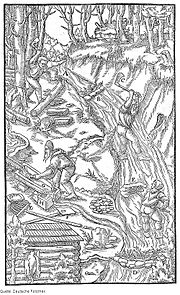
The origins of the place go back to tin mining . Presumably, Cistercians from the Bohemian Osek monastery came across a tin-containing soap deposit in the area of the Seiffenbach in the course of the development of the Ore Mountains in the 13th century and began mining. For this purpose, the boulders of the stream were washed out, for which the light, earthy and sandy components were washed away, while the heavy pewter grains ("pearl barley") remained and could be collected.
Cynsifen are mentioned for the first time in a feudal deed issued in 1324 for Sayda Castle and Purschenstein Castle . It can be assumed that there was already a settlement of the Zinnseifner at that time, but their existence was only proven beyond doubt in 1451 in a feudal letter as czyn Syffen .
In the second half of the 15th century tin was extracted from the solid rock. The focus of the mining was a stock-shaped deposit , which represented a large ore mass worth mined on an area of about 9 hectares and down to a depth of about 30 meters. The tin stick was about 100 meters east of today's Seiffen church. At these Zinnstock still more joined in southern and south-eastern direction courses , which in addition to tin and arsenopyrite , chalcopyrite and Roteisenerz contained. The tin content was up to 1.4 percent in the tin stock and up to 2.9 percent in the veins.
Both civil engineering and open-cast mining were used for the extraction from the bedrock . Driving and dismantling took place u. a. by setting fire , as evidenced by traces of the two Bingen Neuglück and Geyerin , which were created during the opencast mining of the Seiffener Zinnstock.
In 1480, the landlord Kaspar von Schönberg , who was seated at Purschenstein Castle, was given the right to lend the tin mines himself as part of the lower mountain shelf . The von Schönbergs appointed a miner to regulate the mining business .
Mining was mostly done by self-employed workers, i. H. by independent miners who operated their small pits largely for profit and loss. However, the mining was not very profitable, so that the mining town of Seiffen grew only slowly. In 1486 the place had 65 inhabitants with their families in 13 houses, in 1542 there were 58 inhabitants and in 1551 there were already 146 residents.
In the second half of the 16th century a slow boom in mining began. From 1550 the miners began to drive the approximately 600 meter long Johannis tunnel , which drove under the Zinnstock and drained it and was driven even further into the area of the Zinngang. This improved the mining conditions. 1560 existed in the valley of Seiffen stream 8 stamp mills , which comminuted the tin-containing rock before smelting. In 1573, 73 quintals of tin were released. The two main extraction locations, the opencast mining areas of the Bingen Neuglück and Geyerin, are mentioned for the first time in 1570 and 1593, respectively.
In 1600 the von Schönbergs set up a vassal mining office because of the increased importance of ore mining . At around the same time, the Heidengraben was also created as an artificial ditch to channel water from the Schweinitz catchment area to the Seiffen Pochwerke and Erzwäschen.
The population of the mountain village grew to 240 people by 1618. The growing place, which has belonged to the parish of Neuhausen since 1539 , received a mountain chapel around 1570. The Seiffen School was first mentioned in 1620.
In the course of the Thirty Years' War , Bohemian exiles came to Seiffen from 1635 . The population continued to grow, increasing to 380 people by 1660. As the population grew, so did the pressure on the labor market, as not all of the new Seiffen residents could find wages and salaries in the mining industry. Some of the inhabitants turned (forced) to wood processing as their main occupation. As a sideline, wood was already being used in Seiffen in the 16th century a. a. processed into bowls and scoops. This is evidenced by the wood regulations for the Purschenstein area of 1588. In 1650 and 1655, resident wood turners were named in a document for the first time , the objects of daily use such as plates, buttons, spindles, etc. Ä. Manufactured.
Nevertheless, Seiffen remained a mining site. Tin mining reached its peak in the first half of the 18th century. An evaluation of the purchase books indicates that between 1705 and 1755, around 90 percent of the occupations were related to the mining industry. a. Jury (senior mining official), smelter and blacksmith, but only named three turners. The tin yield from the Seiffen and Heidelberg mines was 400 quintals in 1725, 300 quintals in 1729 and even 508 quintals in 1730. At the time of the mining boom, the second Seiffen school was built in 1722.
The tin yield dropped sharply after 1750 due to the depletion of the deposit. In 1772 an output of only 16-18 quintals was registered. With the decline of mining, woodworking developed to a greater extent. Economic hardship forced the miners to turn to woodturning. The formerly more than 30 water-powered stamping mills were shut down and some of them were converted into turning mechanisms. A hydropower turntable that was completed in 1760 has been preserved and can be viewed in the Erzgebirge open-air museum. In addition to the production facilities, the corresponding publishing system also emerged.

In addition to everyday objects, toys were also manufactured at an early stage. From 1760 "Seiffener Ware" was traded across Europe via the trading centers in Nuremberg and Leipzig , and from 1784 it was also exported overseas. The Seiffen wood products quickly prevailed over the products of other toy centers, as they could be produced cheaply and in large assortments in large numbers due to the low wage level in the Ore Mountains.
The Seiffen church , built between 1776 and 1779, has shaped the townscape since the mountain chapel from around 1570 was demolished due to dilapidation. The church, built according to a plan by Christian Gotthelf Reuther (1742–1795) based on the Dresden Frauenkirche , has an octagonal floor plan, which is unusual for a village church. Above the entrance of the church, which is considered a testimony to the piety of the miners, is the dedicatory inscription: "For the glory of God and for the salvation of men". On the church's weather vane there is a cast bronze miner figure referring to tin mining. In 1833 Seiffen became an independent parish .
The wood goods industry, which was expanded to include tire turning in 1810 , developed into Seiffen's decisive economic factor by the first half of the 19th century. In 1771 27 people were active in this area, in 1800 110 people. In 1834 there were 310 interest-paying wood turners, 205 assistants and around 750 helping family members registered and in 1868 937 of 1,438 inhabitants earned their living with the manufacture of toys and wooden goods.
Mining, which was only very weak from the 1780s, ended in 1855, and the Schönberg vassal mining office was dissolved in 1849
In 1852 a state toy school was established, in 1863 in the Steinhübel district and in 1864 in Seiffen a school. In 1875 the volunteer fire brigade was founded. With the Dittersbach-Seiffen station on the Pockau-Lengefeld-Neuhausen railway line , the place received a railway connection in 1895.
Since the beginning of the 20th century, the Seiffen toy makers produced more and more miniaturized figures, houses and vehicles. Small toys were even offered in matchboxes. In addition to rising timber prices, the reason for this trend was the change in customs regulations in important importing countries, which introduced weight duties instead of value-added duties. This made exporting heavy, bulky toys very difficult. In Seiffen, the publisher H. E. Langer made a particular contribution to promoting the process of miniaturization.
In 1909 Seiffen received a new school building (demolished in 2012), and in 1912 the place was connected to the electricity network. In 1919 the trade association of the Erzgebirge toy manufacturers was founded . The town hall was inaugurated in 1927.
At the beginning of the Nazi era in the spring of 1933, an SA storm occupied the workers' sports center, where they imprisoned and tortured political opponents of the Hitler dictatorship before they were taken to other prisons and camps. A memorial stone placed in front of the Hotel Nußknackerbaude in 1948 commemorates the SA terror.
In 1934 the open-air theater was opened. The Striezel children designed by Max Schanz received a gold medal at the Paris World Exhibition in 1937. On April 1, 1939, the communities of Heidelberg, Oberseiffenbach (excluding Oberlochmühle) and the districts of Wettinhöhe and Seiffen-Grund of the community of Niederseiffenbach and the districts of Wetzelhübel (previously Deutschneudorf) and Heidelbach glassworks (previously Neuhausen) were incorporated into Seiffen. The Heidelberg district had its first kindergarten since 1943.
Seiffen is burdened with around 6.5 million euros in debt (as of November 2011), which are mainly due to construction work such as a leisure pool in the 1990s. The Saxon State Ministry of the Interior has promised that if a unified municipality is formed from the previously independent places Seiffen, Heidersdorf and Deutschneudorf, debt relief in the form of a suppression could take place. In contrast, the citizens' initiative Pro Schwartenberggemeinde sought a merger with Neuhausen / Erzgeb. as a Schwartenberg municipality and a related change to the district of central Saxony . On November 13, 2011, a referendum was carried out in which a merger with Neuhausen was rejected by 55% of Seiffen's citizens. The Saxon State Ministry of the Interior had previously announced that a community merger beyond the existing district boundaries would not be approved.
Seiffen has had the addition of a health resort since 1956 and is a state-approved resort .
Heidelbach glassworks
The traditions of glassmaking in Seiffener Winkel go back to around 1200. Since then, glassworks have worked almost continuously in the Frauenbachtal, on the Ahornberg and in the Zankheide (Oberseiffenbach). The Neuhausen church book of 1666 dates the establishment of a glassworks in Heidelbach to the year 1488. The founder is said to have been a member of the Preussler family of glassmakers . The hut produced simple glass for use , but also hollow and flat glasses. Since around 1570, glasses were refined with enamel painting and after 1650 with glass cut. Landowners and initial sponsors of the cabin was on Schloss Purschenstein sedentary family of Schoenberg , who brought the hut considerable profits. The Heidelbacher Glashütte delivered its products to the surrounding area, but also to the cities of Marienberg, Freiberg and Dresden, as well as to the Dresden court and the court cellars in Moritzburg, Torgau and Annaburg. In 1634 the Heidelbacher Glashütte burned down. The smelter Nicol Preußler III. built a new building (lower hut) around 1650, but also had the old hut (upper hut) rebuilt. Salvaged production residues suggest that the lower hut specialized in the production of artistically valuable glass and the upper hut specialized in glass for use. The settlement around the glassworks was first named Heidelbach in 1659. Czech glassmakers also settled here after the Thirty Years' War .
In 1714 the lower glassworks burned down. The fire brought the Preussler family into financial difficulties. So the fire site was sold to the Berg- und Kammerrat Michael Nehmitz. On behalf of the Elector, Nehmitz had supervised the work of Johann Friedrich Böttger on porcelain production and was the first director of the Meissen porcelain factory. The glass utensils Böttger used in his experiments probably also came from the Heidelbacher Hütte. This emerges from a file that says that the glasses came from a glassworks near the Saigerhütte Grünthal . After the decline of the glassworks in Marienberg and Rübenau , the Heidelbacher was the only remaining hut in the Eastern Ore Mountains. Extensive experiments were carried out under Nehmitz to manufacture colored glasses and porcelain. In 1721 he also acquired the upper hut. A year later he transferred both glassworks to his wife Sophie Dorothea, nee. Lichtwer.
The wood shortage, which increased in the second half of the 18th century, also led to the demolition of the upper hut around 1770. Attempts to use hard coal as heating material were unsuccessful. After the downsizing of Saxony by the Congress of Vienna , the Heidelbacher Hütte was the only glassworks in all of Saxony. A conversion into a modern crystal factory, which was also supported by the chief miner Heinrich von Trebra and the Freiberg chemist and metallurgist Wilhelm August Lampadius , failed, however. Since the production of the lower hut became more and more unprofitable, production was also stopped here in 1827, the hut demolished in 1834 and the manor house in 1843. At that time the small settlement had 109 inhabitants (1834). The Gasthaus Glashütte was built on the foundations of the defeat (camp) of the glassworks and was operated until 1992. Today it serves as a residential building. The area of the former Heidelbach glassworks came from Neuhausen / Erzgeb on April 1, 1939 . zu Seiffen (the settlement is now a district of Neuhausen again).
Population development
| Seiffen | Heidelberg | Oberseiffenbach | Niederseiffenbach |
|---|---|---|---|
|
|
|
|
- Statistical data from 1990 to 2007
- Source: Official Gazette of the Seiffen resort. Edition: February 2008
| year | total | Male | Female | Foreigners | Births | Deaths | Marriages | Day care center | Hoard | primary school | Middle school |
|---|---|---|---|---|---|---|---|---|---|---|---|
| 1990 | 3,490 | 1,750 | 1,740 | 0 | 65 | 47 | 22nd | 136 1 | 120 | 217 | 280 |
| 1995 | 3,020 | 1,490 | 1,530 | 5 | 19th | 36 | 16 | 86 | 75 | 176 | 297 |
| 2000 | 2,847 | 1,433 | 1,414 | 3 | 22nd | 32 | 16 | 103 | 47 | 109 | 437 2 |
| 2001 | 2,809 | 1,420 | 1,389 | 3 | 18th | 31 | 16 | 91 | 47 | 114 | 396 |
| 2002 | 2,761 | 1,401 | 1,360 | 2 | 20th | 28 | 14th | 89 | 45 | 115 | 331 |
| 2003 | 2,726 | 1,376 | 1,350 | 2 | 20th | 32 | 12 | 94 | 64 | 133 | 278 |
| 2004 | 2,682 | 1,351 | 1,331 | 2 | 17th | 33 | 19th | 104 | 73 | 144 | 230 |
| 2005 | 2,690 | 1,365 | 1,325 | 12 | 16 | 29 | 16 | 103 | 80 | 158 | 152 |
| 2006 | 2,634 | 1,340 | 1,294 | 13 | 17th | 25th | 32 | 89 | 81 | 161 | 79 |
| 2007 | 2,603 | 1,319 | 1,284 | 7th | 20th | 23 | 20th | 87 | 83 | 163 | 0 3 |
1 = without nursery and kindergarten Oberseiffenbach
2 = closure of Neuhausen middle school
3 = closure of middle school at the end of the 2006/2007 school year
politics
Municipal council
Since the municipal council election on May 26, 2019 , the 13 seats of the municipal council have been distributed among the individual groups as follows:
mayor
Martin Wittig was elected mayor in September 2013.
administration
Seiffen forms an administrative community with Deutschneudorf and Heidersdorf .
Twin town
A partnership with the municipality of Bruck in the Upper Palatinate has existed since 1991 .
Culture and sights
Nature and sport
- Schwartenberg 789 m
- Binge
- Heidengraben , an artificial moat built for mining in the 16th century
- Summer toboggan run
Museums
- Erzgebirge Toy Museum Seiffen : The museum, opened in 1953, shows the development of the Erzgebirge wooden toys from their mining roots to world-famous merchandise. An open-air museum has been affiliated with the museum since 1973, the building complex of which documents everyday life in the Ore Mountains over the past centuries using various houses and workshops.
- Privatmuseum Spielzeugland Max Hetze Seiffen : A museum was opened in Seiffen's oldest shop for the 125th birthday of this toy publisher in 1991. It shows hundreds of exhibits from Seiffen production over the past 100 years, which have been preserved in the publisher's old stocks.
Buildings
- Evangelical Lutheran Church : After a chapel first documented around 1570, a late baroque church with an octagonal floor plan ( octagonal church ) was built from 1776 to 1779 according to a plan by Christian Gotthelf Reuther . The consecration was carried out by Christoph Gottlob Grundig .
- Baude on the Schwartenberg, built in 1936 by the Erzgebirge Association
tourism
The European long-distance hiking trail E3 , the mountain hiking trail Eisenach – Budapest EB and the hiking trail of German unity from Görlitz to Aachen run through Seiffen .
Seiffen is on the bell hiking trail that opened on April 18, 2015 .
The Camping and Holiday Park Regenbogen Seiffen is located above the toy village .
Regular events
- Erzgebirgs-Bike-Marathon : The bike race has been held annually since 1993. It was the first mountain bike marathon held in Germany. In 2016, around 1500 starters took part in the event.
- Christmas market : The Seiffen Christmas market has been held annually since 1990. One of the highlights is the opening on the 1st Saturday of Advent with the pageant, in which, among others, the children's costume group Living Toys and the Seiffen miners' association take part. Another highlight is the big mountain parade on the third Saturday of Advent, where the group of children in traditional costumes and many miners also take part.
See also
List of cultural monuments in Seiffen / Erzgeb.
economy
The economic structure of Seiffen is shaped by tourism and the production and sale of traditional Erzgebirge folk art products .
Within the Ore Mountains, Seiffen is a central production and sales location for wooden toys and is therefore also known as a toy corner. Over 140 handicraft businesses and folk art manufacturers have come together to form Dregeno , the cooperative of woodturners , sculptors, wood and toy manufacturers. The manufacture of folk art products takes place predominantly in small and medium-sized workshops, family and craft businesses. Individual companies such as the Erzgebirgische Volkskunst Richard Glässer GmbH Seiffen also have up to 100 employees.
Production and sale of folk art products shape the appearance of the community, along the main street there are numerous show workshops and folk art shops. During the Advent season , Seiffen is visited by up to 30,000 people on weekends. The Erzgebirge Toy Museum Seiffen has around 50,000 visitors a year.
In an intra-regional comparison, however, Seiffen's economy can be characterized as structurally weak, not least because of its remote location. This is also evidenced by the development of economic indicators in recent years. The number of jobs subject to social security contributions in the community has almost halved between 2000 and 2011. In the course of this contraction process, the number of people employed in the manufacturing sector also fell, albeit by far not as much as that of the total number of employees. At the same time, however, there has also been a reduction in the number of unemployed since 2005.
In tourism, both arrivals and overnight stays declined significantly between 2000 and 2007. Since then, however, there has been significant growth again. In the meantime (2014) the level of the year 2000 has been exceeded. In addition to wood handicrafts, tourism is the main pillar of the local economy. The tourism intensity (indicator for the relative importance of tourism) was around 35 overnight stays per inhabitant in 2014, 7 times as high as the average in the Erzgebirge district (around 5 overnight stays per inhabitant).
| year | Employees subject to social security contributions at the place of work |
Mining and manufacturing people |
Unemployed | Arrivals | Overnight stays | Tax revenue per inhabitant (€) |
Debt per inhabitant (€) |
|---|---|---|---|---|---|---|---|
| 2000 | 1,335 | 322 | 164 | 28,789 | 77,726 | 199 | 1,433 |
| 2005 | 910 | 343 | 239 | 24,682 | 61,330 | 287 | 1,421 |
| 2007 | 792 | 299 | 199 | 21,728 | 52,839 | 403 | 1,334 |
| 2009 | 779 | 271 | 140 | 22,619 | 57,997 | 361 | 1,236 |
| 2011 | 785 | 249 | 93 | 27,812 | 72,841 | 391 | 1,062 |
| 2014 | 786 | 264 | 70 | 30,769 | 78,976 | 412 | 1.007 |
Source: Federal Employment Agency - overview for municipalities / annual figures (number of unemployed), remaining data: State Statistical Office Saxony - Municipal Statistics Saxony
Infrastructure
traffic
- The health resort Seiffen is rather disadvantaged in terms of its connection to the transport infrastructure due to its location in the border region and the long distance to the A 4 and A 72 motorways .
- The opening of the road border crossing between the nearby Deutscheinsiedel and Mníšek in 2002 was a major step forward in improving the connection to the Czech neighboring country .
- The Seiffen (Erzgeb) station, located outside of the village on the Flöha – Pockau-Lengefeld – Neuhausen railway station , has not been served by local rail passenger transport since 2001.
education
- Wooden toy maker and turner school Seiffen (branch of the vocational school center Zschopau )
Personalities
Sons and daughters of the church
- Friedrich Wilhelm Füchtner (1844–1923), folk artist, inventor of the nutcracker as a turning figure
- Auguste Müller (1847–1930), folk artist, carver and man-maker , who died completely impoverished in Seiffen and only achieved cult status after her death
- Karl Müller (man maker) (1879–1958)
- Willy Reichelt (1880–1946), politician (NSDAP)
Persons connected to Seiffen
- Hermann Härtel (pastor) (1865–1919), pastor and promoter of Seiffen folk art
- Max Schanz (1895–1953), teacher and director of the toy school, painter
- Johannes Eichhorn (1904–1993), local history researcher, folklorist and nature conservation officer
- Tino Günther (* 1962), politician, became local chairman of the FDP in 1990 and member of the state parliament from 2004–2014
literature
- About Olbernhau and Seiffen (= values of our homeland . Volume 43). 1st edition. Akademie Verlag, Berlin 1985.
- Martin Hammermüller: The Schwartenberg area . Seiffen - Sayda - Neuhausen. In: Brockhaus-Wanderheft . Number 118. VEB Brockhaus , Leipzig 1974.
- Albrecht Kirsche: Cistercian , glassmaker and turner . Glassworks in the Ore Mountains and Vogtland and their influence on Seiffen wood art. In: Cottbus studies on the history of technology, work and the environment . tape 27 . Waxmann, Münster / Berlin / Munich / New York 2005, ISBN 978-3-8309-1544-7 (with a summary in Czech, also a dissertation at the Technical University of Dresden 2003).
- Association 675 years Seiffen e. V. (Ed.): 675 years of Seiffen . A reading and picture book. Ortschronik working group, Marienberg 1999.
- Seiffen . Visit to toy land. In: Matthias Zwarg (ed.): Free press - leaders . Chemnitzer Verlag, Chemnitz 1999, ISBN 3-928678-55-8 .
Web links
- Alternative site to Seiffen
- Literature about Seiffen / Erzgeb. in the Saxon Bibliography
- Seiffen / Erzgeb. in the digital historical directory of Saxony
- Heidelbach in the Digital Historical Directory of Saxony
- Steinhübel in the Digital Historical Directory of Saxony
Individual evidence
- ↑ Population of the Free State of Saxony by municipalities on December 31, 2019 ( help on this ).
- ↑ a b Saxon Official Gazette of February 19, 2015 (PDF), accessed on December 29, 2017.
- ^ Association 675 Years Seiffen e. V. (Ed.): 675 years of Seiffen. Marienberg 1999, p. 6.
- ↑ To Olbernhau and Seiffen (= values of our homeland . Volume 43). 1st edition. Akademie Verlag, Berlin 1985, p. 132.
- ↑ a b Pinge Neuglück and Binge Geyerin in the MonE database ( Memento from June 22, 2015 in the Internet Archive )
- ↑ a b Bergarchiv Freiberg - Vasallenbergamt Sachsen ( Memento from October 11, 2014 in the Internet Archive )
- ↑ The conversion of the mountain village of Seiffen to toy production. in: Sächsische Heimatblätter 11 (1965) 6, p. 484.
- ^ Otfried Wagenbreth , Eberhard Wächtler : Mining in the Ore Mountains. Technical monuments and history. Leipzig 1990, p. 192.
- ↑ To Olbernhau and Seiffen (= values of our homeland . Volume 43). 1st edition. Akademie Verlag, Berlin 1985, p. 132f.
- ↑ a b Association 675 Years Seiffen e. V. (Ed.): 675 years of Seiffen . Marienberg 1999, p. 105.
- ↑ a b About Olbernhau and Seiffen (= values of our homeland . Volume 43). 1st edition. Akademie Verlag, Berlin 1985, p. 138.
- ^ Association 675 Years Seiffen e. V. (Ed.): 675 years of Seiffen. Marienberg 1999, p. 21.
- ^ Karl-Ewald Fritzsch: From miner to toy maker. in: German yearbook for folklore. Volume 2, Berlin 1956, pp. 179-211.
- ^ Association 675 Years Seiffen e. V. (Ed.): 675 years of Seiffen. Marienberg 1999, p. 16
- ^ Association 675 Years Seiffen e. V. (Ed.): 675 years of Seiffen. Marienberg 1999, p. 17.
- ^ Förderverein Montanregion Erzgebirge e. V. (Ed.): Implementation study of the Toy Village Seiffen. Freiberg 2012, p. 9f.
- ^ Otfried Wagenbreth, Eberhard Wächtler: Mining in the Ore Mountains. Technical monuments and history. Leipzig 1990, p. 194.
- ^ Website of the Erzgebirge Toy Museum in Seiffen ( Memento from March 18, 2010 in the Internet Archive )
- ↑ Hotel Nussknackerbaude Seiffen in the Ore Mountains - Hotel - Your hotel in Seiffen in the Ore Mountains .
- ↑ Freie Presse Online from November 4, 2011: State Secretary: Debt relief only possible with a single community.
- ↑ Freie Presse Online from November 13, 2011: Seiffen: majority against merger with Neuhausen - only 43 percent in favor of merger plan.
- ↑ Results of the 2014 municipal council elections .
- ^ Votum - Seiffener elect Martin Wittig - Freie Presse - Zschopau .
- ↑ Schwartenbergbaude homepage
- ↑ Homepage Glässer GmbH in the web archive ; Accessed December 25, 2010; Retrieved January 7, 2018.
- ↑ Original instead of plagiarism in the web archive. (PDF) Deutsche Welle ; accessed on January 7, 2018.
- ↑ Homepage of the Toy Museum ( Memento from January 31, 2012 in the Internet Archive )
- ↑ Korff Agency for Regional Development: Integrated Rural Development Concept “Silbernes Erzgebirge” , Dippoldiswalde 2007, p. 25 ( Memento from January 31, 2012 in the Internet Archive ) (PDF; 4.5 MB).
- ↑ Unemployed and underemployed . Arbeitsagentur.de. Retrieved October 27, 2019.
- ^ Regional data, municipal statistics, Saxony . State Statistical Office of Saxony. Retrieved October 27, 2019.

